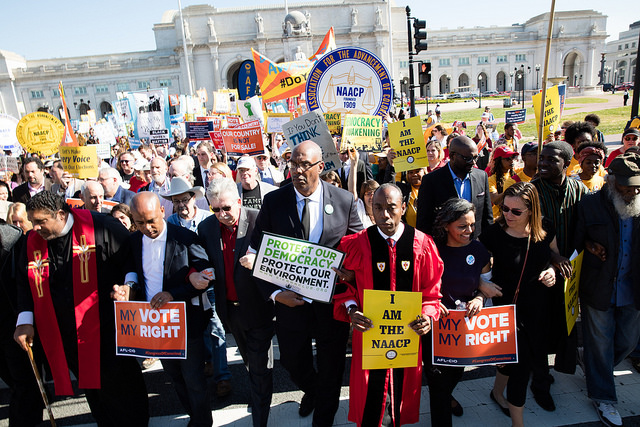May 26, 2017
Civil Rights and Labor: Two Movements, One Goal
by Richard Womack Sr. ,James Settles Jr.,Robin Williams
Originally published on the AFL-CIO blog
One of our most celebrated labor leaders, A. Philip Randolph, an organizer of the 1963 March on Washington, knew the connection between the labor movement and the civil rights movement was key to a truly inclusive democracy. He stood for access at the ballot box as well as to economic security—ideally through a good job with decent benefits and a union. Today, we find ourselves back in a place where our civil, economic, political and social rights are under constant attack. The violence we see against black youth—the heart-wrenching killing of Trayvon Martin, the homicide of Jordan Davis–the passage of “right to work” laws in states like Michigan, Missouri and Iowa that have deeply racist and divisive roots, and the constant attack on immigrant communities by the current administration affirm we still have work to do.
As trade unionists, labor leaders, parents and civil rights activists, we have dedicated our time, talent and resources to advancing the agenda for people who are simply working for a better life. We believe there has never been a more critical point in our nation’s history when it is so crucial for us to reconnect deeply the movement for working people with the movement for civil and human rights. We cannot forget that the March on Washington was about freedom, economic equity and good jobs. The intersection of human rights, civil rights and workers’ rights has always been a part of our struggles for independent power both here and abroad. We must continue to uplift those movements in an intersectional way to ensure we are able to win justice at the workplace and the ballot box to make a difference for those we serve.
This summer, one of the oldest and largest civil and human rights organizations, the NAACP, will come to the city of Baltimore for its annual convention. The NAACP has stood as a coalition partner to the labor movement since 1909. There are many organizations we as a movement value and partner with through shared program and the NAACP remains one of those core allies, despite the shifts that happen in the world around us. We have great leadership within both the labor movement and the NAACP. We have seen how powerful it is when leaders like AFT’s Lorretta Johnson stand shoulder to shoulder with the Rev. William Barber, leader of the NAACP North Carolina State Conference. We know our journey together must continue as we fight to assure that “the humblest and weakest person can enjoy the highest civil, economic and social rights that the biggest and most powerful possess.”
We must expand our vision by creating solidarity without borders so that working people will be treated with the respect we are due. Thus our history and our very purpose demand that we be in the forefront of the struggle to assure first-class citizenship to all people, of all colors, and all creeds without regard to sex, sexual orientation or gender identity. Our struggles are one; our hopes are one; our dreams are one. The past is not dead, it’s not even past.
To participate in the 2017 NAACP Labor Luncheon in Baltimore, please click here: cvent.com/d/n5q3qx
James Settles Jr., also known as Jimmy, serves as a vice president and member of the Executive Board at the UAW. He is a national board member and Labor Committee vice-chair of the NAACP.
Robin Williams serves as the national vice president of the United Food and Commercial Workers (UFCW). She is a national board member and Labor Committee vice-chair of the NAACP.
Richard Womack Sr. is the emeritus assistant to the AFL-CIO president and former director of the AFL-CIO Civil, Human and Women’s Rights Department. He is a national board member and Labor Committee chair of the NAACP.
